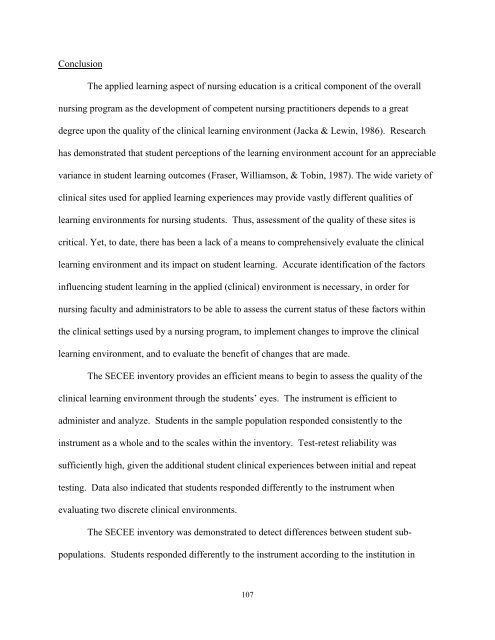STUDENT EVALUATION OF CLINICAL EDUCATION ENVIRONMENT
STUDENT EVALUATION OF CLINICAL EDUCATION ENVIRONMENT
STUDENT EVALUATION OF CLINICAL EDUCATION ENVIRONMENT
Create successful ePaper yourself
Turn your PDF publications into a flip-book with our unique Google optimized e-Paper software.
Conclusion<br />
The applied learning aspect of nursing education is a critical component of the overall<br />
nursing program as the development of competent nursing practitioners depends to a great<br />
degree upon the quality of the clinical learning environment (Jacka & Lewin, 1986). Research<br />
has demonstrated that student perceptions of the learning environment account for an appreciable<br />
variance in student learning outcomes (Fraser, Williamson, & Tobin, 1987). The wide variety of<br />
clinical sites used for applied learning experiences may provide vastly different qualities of<br />
learning environments for nursing students. Thus, assessment of the quality of these sites is<br />
critical. Yet, to date, there has been a lack of a means to comprehensively evaluate the clinical<br />
learning environment and its impact on student learning. Accurate identification of the factors<br />
influencing student learning in the applied (clinical) environment is necessary, in order for<br />
nursing faculty and administrators to be able to assess the current status of these factors within<br />
the clinical settings used by a nursing program, to implement changes to improve the clinical<br />
learning environment, and to evaluate the benefit of changes that are made.<br />
The SECEE inventory provides an efficient means to begin to assess the quality of the<br />
clinical learning environment through the students’ eyes. The instrument is efficient to<br />
administer and analyze. Students in the sample population responded consistently to the<br />
instrument as a whole and to the scales within the inventory. Test-retest reliability was<br />
sufficiently high, given the additional student clinical experiences between initial and repeat<br />
testing. Data also indicated that students responded differently to the instrument when<br />
evaluating two discrete clinical environments.<br />
The SECEE inventory was demonstrated to detect differences between student sub-<br />
populations. Students responded differently to the instrument according to the institution in<br />
107












